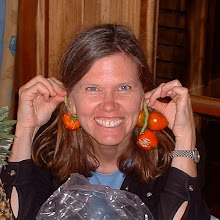I admire people that take an idea and explore it in depth with different variations. That has not been the case with my recent temari. They really have nothing in common with each other except that they are both nicely round.
This temari is the pattern called Buttercups in Barbara Suess's Temari Techniques book. Contrariwise as usual, I stitched in the complementary colors to her design, using several shades of purple. I like to call it Deep Purple. To fill in the diamonds I used a rayon thread from Morocco that my sister gave me some time ago. I really like the contrast of the cotton perlé and the synthetic. The latter is slightly more difficult to stitch with. (I needed to twist my needle to keep the thread sufficiently twisted. The extra effort was worth it and I plan to use it again.)
The other recent temari I stitched is from a Japanese book (ISBN978-4-8377-0395-2). It has bands wrapped on a C8 marking and then kiku stitches to make flowers in a random pattern.
It wasn't challenging figuring out the charts in the book for this particular pattern but I was grateful to a Japanese friend for translating the part that basically says stitch the kiku as the spirit moves you. Even though you can't see them all in the book, theirs has eight flowers. My spirit moved me to stitch seven.
This temari is the pattern called Buttercups in Barbara Suess's Temari Techniques book. Contrariwise as usual, I stitched in the complementary colors to her design, using several shades of purple. I like to call it Deep Purple. To fill in the diamonds I used a rayon thread from Morocco that my sister gave me some time ago. I really like the contrast of the cotton perlé and the synthetic. The latter is slightly more difficult to stitch with. (I needed to twist my needle to keep the thread sufficiently twisted. The extra effort was worth it and I plan to use it again.)
The other recent temari I stitched is from a Japanese book (ISBN978-4-8377-0395-2). It has bands wrapped on a C8 marking and then kiku stitches to make flowers in a random pattern.
It wasn't challenging figuring out the charts in the book for this particular pattern but I was grateful to a Japanese friend for translating the part that basically says stitch the kiku as the spirit moves you. Even though you can't see them all in the book, theirs has eight flowers. My spirit moved me to stitch seven.








